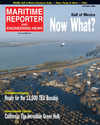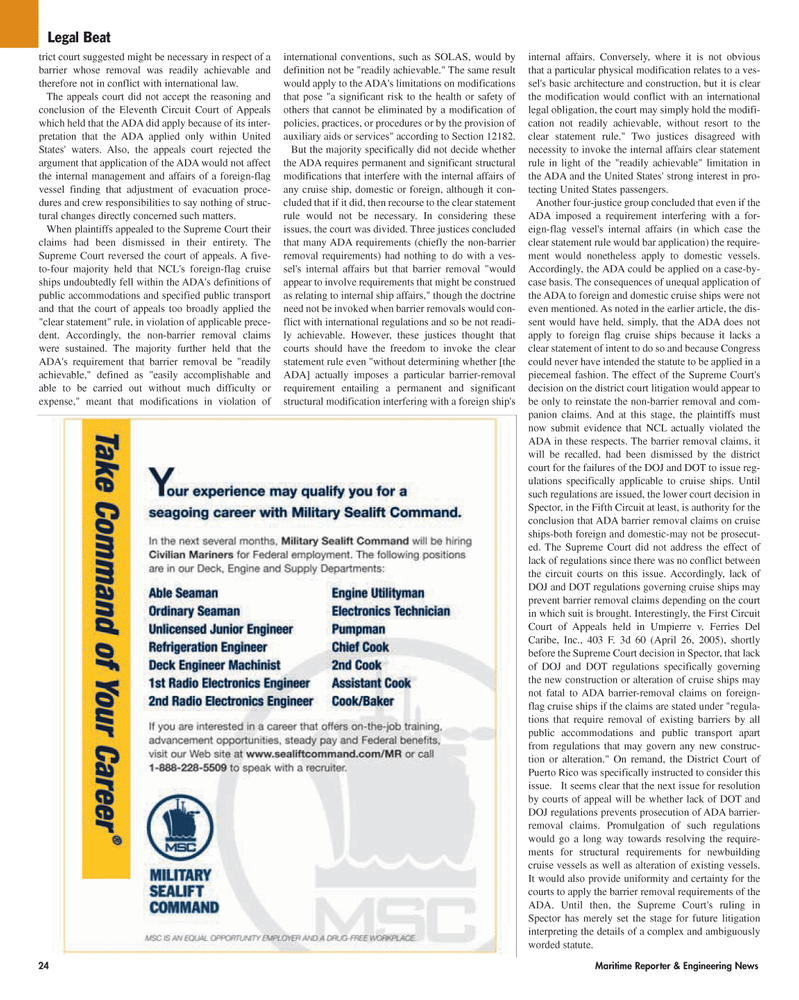
Page 24: of Maritime Reporter Magazine (November 2005)
The Workboat Annual Edition
Read this page in Pdf, Flash or Html5 edition of November 2005 Maritime Reporter Magazine
24 Maritime Reporter & Engineering News trict court suggested might be necessary in respect of a barrier whose removal was readily achievable and therefore not in conflict with international law.
The appeals court did not accept the reasoning and conclusion of the Eleventh Circuit Court of Appeals which held that the ADA did apply because of its inter- pretation that the ADA applied only within United
States' waters. Also, the appeals court rejected the argument that application of the ADA would not affect the internal management and affairs of a foreign-flag vessel finding that adjustment of evacuation proce- dures and crew responsibilities to say nothing of struc- tural changes directly concerned such matters.
When plaintiffs appealed to the Supreme Court their claims had been dismissed in their entirety. The
Supreme Court reversed the court of appeals. A five- to-four majority held that NCL's foreign-flag cruise ships undoubtedly fell within the ADA's definitions of public accommodations and specified public transport and that the court of appeals too broadly applied the "clear statement" rule, in violation of applicable prece- dent. Accordingly, the non-barrier removal claims were sustained. The majority further held that the
ADA's requirement that barrier removal be "readily achievable," defined as "easily accomplishable and able to be carried out without much difficulty or expense," meant that modifications in violation of international conventions, such as SOLAS, would by definition not be "readily achievable." The same result would apply to the ADA's limitations on modifications that pose "a significant risk to the health or safety of others that cannot be eliminated by a modification of policies, practices, or procedures or by the provision of auxiliary aids or services" according to Section 12182.
But the majority specifically did not decide whether the ADA requires permanent and significant structural modifications that interfere with the internal affairs of any cruise ship, domestic or foreign, although it con- cluded that if it did, then recourse to the clear statement rule would not be necessary. In considering these issues, the court was divided. Three justices concluded that many ADA requirements (chiefly the non-barrier removal requirements) had nothing to do with a ves- sel's internal affairs but that barrier removal "would appear to involve requirements that might be construed as relating to internal ship affairs," though the doctrine need not be invoked when barrier removals would con- flict with international regulations and so be not readi- ly achievable. However, these justices thought that courts should have the freedom to invoke the clear statement rule even "without determining whether [the
ADA] actually imposes a particular barrier-removal requirement entailing a permanent and significant structural modification interfering with a foreign ship's internal affairs. Conversely, where it is not obvious that a particular physical modification relates to a ves- sel's basic architecture and construction, but it is clear the modification would conflict with an international legal obligation, the court may simply hold the modifi- cation not readily achievable, without resort to the clear statement rule." Two justices disagreed with necessity to invoke the internal affairs clear statement rule in light of the "readily achievable" limitation in the ADA and the United States' strong interest in pro- tecting United States passengers.
Another four-justice group concluded that even if the
ADA imposed a requirement interfering with a for- eign-flag vessel's internal affairs (in which case the clear statement rule would bar application) the require- ment would nonetheless apply to domestic vessels.
Accordingly, the ADA could be applied on a case-by- case basis. The consequences of unequal application of the ADA to foreign and domestic cruise ships were not even mentioned. As noted in the earlier article, the dis- sent would have held, simply, that the ADA does not apply to foreign flag cruise ships because it lacks a clear statement of intent to do so and because Congress could never have intended the statute to be applied in a piecemeal fashion. The effect of the Supreme Court's decision on the district court litigation would appear to be only to reinstate the non-barrier removal and com- panion claims. And at this stage, the plaintiffs must now submit evidence that NCL actually violated the
ADA in these respects. The barrier removal claims, it will be recalled, had been dismissed by the district court for the failures of the DOJ and DOT to issue reg- ulations specifically applicable to cruise ships. Until such regulations are issued, the lower court decision in
Spector, in the Fifth Circuit at least, is authority for the conclusion that ADA barrier removal claims on cruise ships-both foreign and domestic-may not be prosecut- ed. The Supreme Court did not address the effect of lack of regulations since there was no conflict between the circuit courts on this issue. Accordingly, lack of
DOJ and DOT regulations governing cruise ships may prevent barrier removal claims depending on the court in which suit is brought. Interestingly, the First Circuit
Court of Appeals held in Umpierre v. Ferries Del
Caribe, Inc., 403 F. 3d 60 (April 26, 2005), shortly before the Supreme Court decision in Spector, that lack of DOJ and DOT regulations specifically governing the new construction or alteration of cruise ships may not fatal to ADA barrier-removal claims on foreign- flag cruise ships if the claims are stated under "regula- tions that require removal of existing barriers by all public accommodations and public transport apart from regulations that may govern any new construc- tion or alteration." On remand, the District Court of
Puerto Rico was specifically instructed to consider this issue. It seems clear that the next issue for resolution by courts of appeal will be whether lack of DOT and
DOJ regulations prevents prosecution of ADA barrier- removal claims. Promulgation of such regulations would go a long way towards resolving the require- ments for structural requirements for newbuilding cruise vessels as well as alteration of existing vessels.
It would also provide uniformity and certainty for the courts to apply the barrier removal requirements of the
ADA. Until then, the Supreme Court's ruling in
Spector has merely set the stage for future litigation interpreting the details of a complex and ambiguously worded statute.
Legal Beat
MR NOVEMBER 2005 #3 (17-24).qxd 10/28/2005 9:40 AM Page 24

 23
23

 25
25
